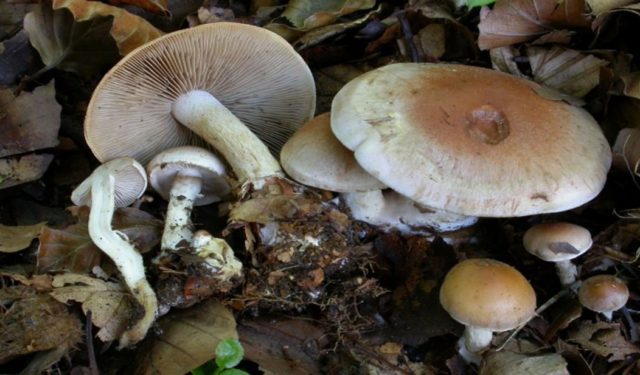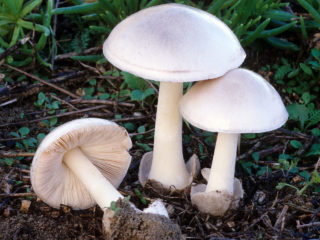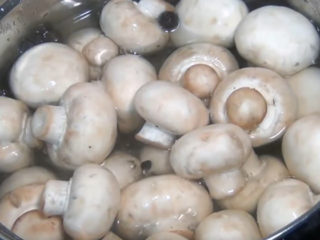Content
Gebeloma girdled is a member of the Hymenogasteraceae family, genus Gebeloma. The Latin name of this species is hebeloma mesophaeum. This mushroom is also known as Hebeloma burosmedian.
What does hebeloma girdled look like?

Some older specimens may have wavy edges
You can recognize this species by the following characteristics of the fruiting body:
- At a young age, the cap of Hebeloma girdled is convex with folded edges inward, gradually straightens, becomes wide - bell-shaped, prostrate or even depressed. At the edges you can sometimes see the remains of the bedspread.The size of the cap in diameter varies from 2 to 7 cm. The surface is smooth, a little sticky during the rainy season. Colored in yellow-brown or pinkish-brown shades with a darker center and lighter edges.
- On the underside of the cap there are wide and rather dense plates. With a magnifying glass you can see that their edges are slightly wavy. At the initial stage of ripening they are colored cream or light pink; over time they acquire brown shades.
- The spores are ellipsoidal, practically smooth. The spore powder is pale brown or with a pinkish tint.
- The leg is slightly curved, close to cylindrical, the length ranges from 2 to 9 cm, and the thickness is up to 1 cm in diameter. Smooth and silky to the touch. In some specimens it may be expanded at the base. White when young, becoming brown with darker shades underneath as they mature. Sometimes in the central part of the leg you can see a ring zone, but without the remains of the veil.
- The pulp is quite thin, whitish in color. It has a rare odor and a bitter taste.
Where does Hebeloma girdled grow?
This species can be found in late summer or autumn, and in mild climates even in winter. As a rule, it lives in forests of various types, forming mycorrhizae with deciduous and coniferous trees. Also quite often, hebeloma girdled is found in parks, gardens and any other grassy places. Prefers to grow in regions with a temperate climate. Most often it grows in large groups.
Is it possible to eat hebeloma girdled?
Most reference books classify this species as a conditionally edible or edible mushroom.However, experts do not recommend eating Hebeloma girtula for a number of reasons:
- its pulp has a bitter taste, similar to radish;
- Regarding this species, there are difficulties in determining edibility;
- quite difficult to distinguish from their inedible and poisonous counterparts.
Twins of Hebeloma girdled

This species has many poisonous counterparts
In terms of external features, this mushroom is very similar to inedible forest products, which even experienced mushroom pickers cannot always distinguish. These include:
- Hebeloma mustard – a poisonous mushroom, use as food leads to intoxication. Within a couple of hours after consumption, the first signs appear: nausea, abdominal pain, vomiting and diarrhea. It differs from hebeloma girdled by the large size of the fruiting bodies. Thus, the double’s cap reaches up to 15 cm. The color varies from beige to red-brown with lighter edges. The surface is shiny and sticky to the touch. The leg is cylindrical, about 15 cm long. The taste and smell are very similar to the species in question. Grows in various forests within temperate climates.
- Gebeloma inaccessible – is an inedible specimen, consumption leads to poisoning. You can distinguish the double by the flat cap pressed in the middle. It is painted in a reddish color, fades to white as it matures. The pulp is very bitter with a rare smell. A distinctive feature is also a twisted leg, bent in several places at once.
- Gebeloma coal-loving - is a small fruiting body, the cap is about 2-4 cm in diameter. During the rainy season, its surface is covered with a copious layer of mucus. The color is uneven, often the edge is whitish, and closer to the center it is yellow-brown.The height of the leg reaches 4 cm, its surface is rough. The entire length is covered with a coating, and at the base it is slightly pubescent. It grows everywhere on the remains of fire pits, burnt areas and conflagrations. The pulp of the double has a bitter taste, which is why it belongs to the group of inedible mushrooms.
Conclusion
Gebeloma girdled is an edible specimen with a graceful stalk and a dark cap. But due to the fact that most relatives of the Gebeloma genus are inedible or poisonous, this specimen is not recommended for consumption. Experts have not yet reached a consensus on this specimen.











